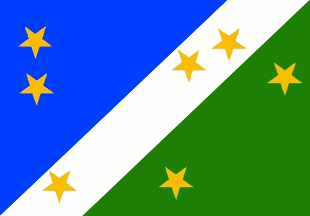 image by Dirk Schönberger,
12 March
2010
image by Dirk Schönberger,
12 March
2010
Last modified: 2012-02-11 by ian macdonald
Keywords: ceará | são gonçalo do amarante |
Links: FOTW homepage |
search |
disclaimer and copyright |
write us |
mirrors
 image by Dirk Schönberger,
12 March
2010
image by Dirk Schönberger,
12 March
2010
Based on http://pt.wikipedia.org/wiki/S%C3%A3o_Gon%C3%A7alo_do_Amarante_%28Cear%C3%A1%29
Divided per bend sinister, with seven gold stars scattered on the flag.
Official website at http://pmsga.com.br;
the flag is shown on Wikipedia at
http://pt.wikipedia.org/wiki/São_Gonçalo_do_Amarante_(Ceará).
Dirk Schönberger, 12 March 2010
The municipality of São Gonçalo do Amarante (43,947 inhabitants in 2010; 834
sq. km) is located on coastal Ceará, 60 km of Fortaleza.
São Gonçalo do Amarante was settled around 1680, when the first colonial settlements
appeared in São Gonçalo and Siupé. From 1943 to 1951, the municipality was
renamed Anacetaba, as a tribute to the Anaces natives, the first inhabitants
of the area. The name of São Gonçalo do Amarante was eventually established
by Municipal Law No. 1,153 of 22 November 1951. Once a rural municipality,
São Gonçalo do Amarante has developed tourism in the Pecém, Taíba and Colônia
beaches and the Prejubaca laguna, and industry in the business park and port
of Pecém.
The municipality is named for its patron saint, Gonzalo de
Amarante (1187-1259; blessed in 1560 by Pope Pius IV), a Portuguese Dominican
friar who lived as an hermit. Gonzalo de Amarante is the patron saint of
several Brazilian towns, which honor in a festival called Gonzalo's Dance ("Baile
de São Gonçalo", "Roda de São Gonçalo"); this festival appeared in Brazil in
the early 18th century while it had been known in Portugal since the 13th
century.
The flag of São Gonçalo do Amarante is prescribed by
Municipal Law No. 146 of 15 July 1975, as follows.
"Symbolism: Blue
for the sky; Green for the sea; Yellow for the sun; White for peace.
The districts are symbolized by a star placed on the flag according to
their respective geographic location. The seat of the municipality is
represented by the seven stars together.
Colors: The rectangular flag
is formed by two right-angle triangles of the following colors: Blue in
the upper left part; Green in the lower right part; White, as a a
parallelogram separating the two triangles; Yellow, on seven stars
representing the seven districts.
Meaning of the stars: In the blue
triangle, the lower star represents Serrote while the upper star represents
Cágado. In the white parallelogram, the lower star represents Croatá, the
middle star represents Siupé and the upper star represents Taíba. In the
green triangle, the lower star represents Umarituba and the upper star
represents Pecém."
http://www.pmsga.com.br/municipio/bandeira.asp -
Municipal website
Ivan Sache, 15 January 2012